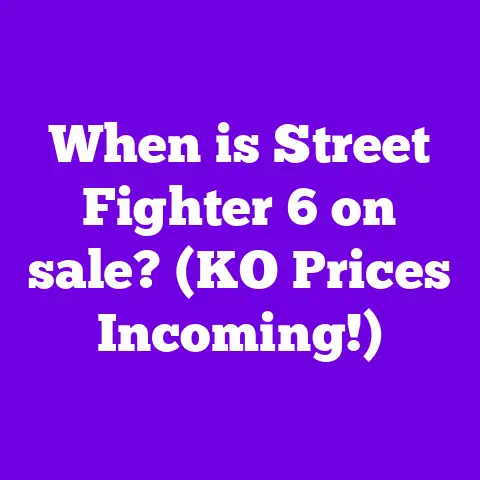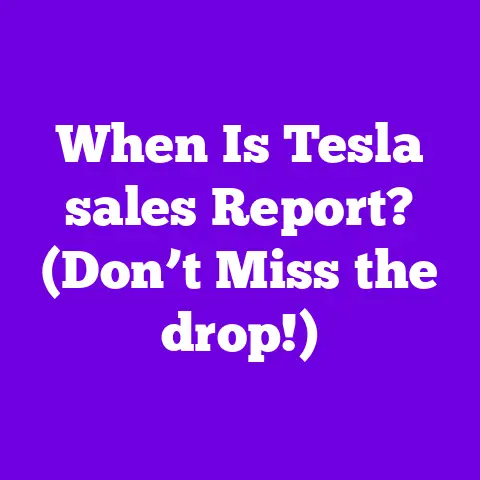When’s The Next Big sale? (Don’t Miss These Deals!)
For generations, the tradition of the annual sale has been woven into the fabric of consumer culture.
It’s more than just a discount; it’s an event, a ritual anticipated with the same fervor as holidays and celebrations.
Think about it: the collective sigh of relief as prices plummet, the thrill of snagging a coveted item at a fraction of its original cost, and the shared experience of navigating crowded stores (or bustling online marketplaces) with fellow bargain hunters.
These are the moments that define the annual sale, transforming a simple shopping trip into something far more significant.
The evolution of sales traditions mirrors societal shifts in spending and consumer behavior.
From humble seasonal discounts tied to the agricultural calendar (think harvest sales) to the modern behemoths of Black Friday and Cyber Monday, sales events have adapted to the times.
The rise of e-commerce has democratized access, allowing consumers worldwide to participate in these events from the comfort of their homes.
We’ve moved from physically lining up outside stores before dawn to setting alarms to catch flash sales online.
This evolution reflects a fundamental change in how we consume and interact with brands.
The excitement surrounding big sales is palpable.
It’s akin to the anticipation of a birthday or a holiday, a feeling fueled by marketing campaigns, social media buzz, and the promise of incredible deals.
This excitement taps into deep-seated cultural practices, connecting the act of shopping with the joy of celebration and the satisfaction of a good bargain.
As someone who has spent countless hours researching the best deals and strategizing my shopping sprees, I understand the allure firsthand.
It’s not just about saving money; it’s about the thrill of the hunt and the satisfaction of a well-executed purchase.
Historical Context of Sales Events: From Humble Beginnings to Global Phenomena
To truly understand the significance of the 2025 sales landscape, it’s crucial to delve into the history of major sales events.
Let’s take a look at some key players:
- Black Friday: Arguably the most iconic sales event, Black Friday’s origins are somewhat murky.
One theory suggests it stems from retailers finally moving “into the black” (profitability) after a year of losses, fueled by the post-Thanksgiving shopping rush.
Another, darker theory links it to the chaotic traffic and crowds following Thanksgiving in Philadelphia.
Regardless of its exact origin, Black Friday has transformed from a single day of in-store mayhem to a multi-day, omnichannel extravaganza. - Cyber Monday: Born in the early 2000s, Cyber Monday was conceived as the online equivalent of Black Friday.
Initially, it targeted consumers who didn’t have time to shop in stores on Black Friday but could browse online from their work computers on Monday.
As e-commerce exploded, Cyber Monday quickly became a force to be reckoned with, often surpassing Black Friday in online sales volume. - Other Notable Sales: Beyond Black Friday and Cyber Monday, a host of other sales events have carved out their niche, including:
- Amazon Prime Day: A relative newcomer, Amazon Prime Day (launched in 2015) has quickly become a major mid-year sales event, driving significant revenue for Amazon and putting pressure on other retailers to offer competing deals.
- Back-to-School Sales: A long-standing tradition, Back-to-School sales target parents preparing their children for the upcoming academic year, offering discounts on everything from clothing and school supplies to electronics.
- Holiday Sales (Christmas, Easter, Valentine’s Day): The Christmas sales period is the most important sales period for retailers.
The impact of these sales on consumer habits and retail strategies is undeniable.
They have fundamentally reshaped the way people shop, creating a culture of deal-seeking and instant gratification.
Retailers, in turn, have adapted by investing heavily in marketing, optimizing their supply chains, and developing sophisticated pricing strategies to maximize profits during these peak periods.
According to the National Retail Federation (NRF), Black Friday weekend (Thanksgiving through Cyber Monday) consistently accounts for a significant portion of annual retail sales in the United States.
In 2022, approximately 196.7 million U.S.
shoppers took advantage of the long Thanksgiving weekend.
(Source: NRF)
The Major Sales Events in 2025: A Calendar of Savings
Looking ahead to 2025, here’s a glimpse at the most anticipated sales events and what consumers can expect:
New Year’s Day Sales (January 1st): While often overshadowed by the holiday season, New Year’s Day sales offer a chance to snag deals on leftover holiday inventory, as well as fitness equipment, home goods, and winter apparel.
Expect discounts ranging from 20% to 70% off.Valentine’s Day Promotions (February 14th): Retailers capitalize on the romantic spirit of Valentine’s Day with promotions on jewelry, flowers, chocolates, and experiences.
I expect to see retailers like Tiffany’s, Godiva and local restaurants offering discounts of 10%-30% on select items.Easter Sales (Late March/Early April): Easter sales typically focus on spring apparel, home décor, and, of course, candy.
Expect discounts of up to 50% off seasonal items.Memorial Day Weekend (Late May): Memorial Day Weekend is a major sales event for outdoor gear, appliances, and furniture.
Retailers often offer significant discounts on these items, as well as travel deals.
I expect to see retailers like Home Depot, Lowes and Best Buy offering discounts on appliances.Amazon Prime Day (Mid-July): Amazon Prime Day is a 48-hour shopping event that offers exclusive deals to Amazon Prime members.
Expect discounts on a wide range of products, including electronics, home goods, and clothing.
I expect the date of the sale to be between the 14-16 of July.Back-to-School Sales (July-August): Back-to-School sales target parents preparing their children for the upcoming academic year, offering discounts on everything from clothing and school supplies to electronics.
Expect discounts of 10%-50% off select items.Labor Day Sales (Early September): Labor Day sales mark the unofficial end of summer and offer discounts on summer apparel, outdoor gear, and mattresses.
Expect discounts of 20%-60% off select items.Halloween (October 31st): Halloween sales focus on costumes, decorations, and candy.
Expect discounts of up to 50% off seasonal items.Black Friday (Late November): The king of all sales events, Black Friday offers deep discounts on a wide range of products, from electronics and appliances to clothing and toys.
Expect long lines and fierce competition for the best deals.-
Cyber Monday (Late November): The online counterpart to Black Friday, Cyber Monday offers similar discounts on a wide range of products, but with the convenience of shopping from home.
Christmas Sales (December): The Christmas sales period is the most important sales period for retailers.
Expect discounts on a wide range of products, including gifts, decorations, and holiday apparel.
Potential New Trends for 2025:
- Increased Focus on Sustainability: Consumers are increasingly demanding sustainable products and practices.
I anticipate that retailers will respond by offering more discounts on eco-friendly items and highlighting their sustainability initiatives during sales events. - Personalized Deals: With the rise of AI and data analytics, retailers are becoming increasingly sophisticated at personalizing deals based on individual consumer preferences and shopping habits.
Expect to see more targeted offers and customized recommendations during sales events. - Livestream Shopping: Livestream shopping, where influencers and retailers showcase products and offer exclusive deals in real-time, is gaining popularity.
I expect to see more retailers incorporating livestream shopping into their sales strategies in 2025.
Understanding Consumer Behavior During Sales: The Psychology of the Deal
The frenzy surrounding major sales events isn’t just about saving money; it’s also about psychology.
Consumers employ various strategies to maximize their savings, often driven by psychological factors that influence their buying decisions.
Strategies for Maximizing Savings:
- Creating Wish Lists: Savvy shoppers create wish lists in advance of sales events, allowing them to quickly identify and purchase desired items when prices drop.
- Using Price Comparison Tools: Price comparison tools like Google Shopping and PriceGrabber help consumers compare prices across different retailers, ensuring they’re getting the best possible deal.
- Subscribing for Alerts: Signing up for email alerts and following retailers on social media allows consumers to stay informed about upcoming sales and exclusive discounts.
Psychological Factors at Play:
- Urgency: Limited-time offers and flash sales create a sense of urgency, prompting consumers to make quick decisions and avoid missing out on a deal.
- Scarcity: Retailers often highlight limited quantities or “while supplies last” offers to create a sense of scarcity, driving demand and encouraging consumers to purchase items before they sell out.
- Social Proof: Positive reviews and testimonials from other shoppers can influence buying decisions, providing social proof that a product is worth purchasing.
Retailer Strategies for 2025 Sales: Preparing for the Onslaught
Retailers invest significant time and resources in planning for major sales events.
Their strategies encompass marketing, inventory management, and customer engagement tactics.
Key Strategies:
- Aggressive Marketing Campaigns: Retailers launch aggressive marketing campaigns across various channels (TV, online, social media) to generate buzz and drive traffic to their stores and websites.
- Optimized Inventory Management: Retailers carefully manage their inventory to ensure they have enough stock to meet demand during peak periods, while also avoiding overstocking and potential losses.
- Enhanced Customer Engagement: Retailers employ various tactics to engage customers, such as loyalty programs, personalized recommendations, and exclusive deals for subscribers.
Anticipated Changes in Sales Strategies for 2025:
- Increased Use of AI: Retailers are increasingly using AI to personalize deals, optimize pricing, and improve customer service during sales events.
- Focus on Omnichannel Experience: Retailers are striving to create a seamless shopping experience across all channels (online, in-store, mobile), allowing customers to shop however they prefer.
- Emphasis on Mobile Shopping: With the increasing prevalence of mobile devices, retailers are optimizing their websites and apps for mobile shopping, making it easier for customers to browse and purchase items on the go.
Tips for Shoppers to Navigate 2025 Sales: A Guide to Savvy Shopping
To effectively participate in the 2025 sales landscape, consumers need to be informed and prepared.
Here are some practical tips:
- Plan Ahead: Create a budget, make a list of desired items, and research prices in advance.
- Compare Prices: Use price comparison tools to ensure you’re getting the best possible deal.
- Read Reviews: Check online reviews to get feedback from other shoppers before making a purchase.
- Understand Return Policies: Familiarize yourself with retailers’ return policies before making a purchase, in case you need to return an item.
- Shop Early: Avoid the crowds and potential stockouts by shopping early in the sales event.
- Be Patient: Navigating crowded stores and websites can be frustrating, so be patient and take your time.
Future of Sales Events: Beyond 2025
The future of sales events is likely to be shaped by several key trends, including the influence of social media, sustainability in consumer choices, and the growing importance of online shopping.
Potential Trends:
- Social Media Commerce: Social media platforms are becoming increasingly important for shopping, with features like shoppable posts and in-app purchasing.
I expect to see more retailers leveraging social media to drive sales during sales events. - Sustainability and Ethical Consumption: Consumers are increasingly demanding sustainable and ethically sourced products.
Retailers that prioritize sustainability and ethical practices are likely to gain a competitive advantage. - Augmented Reality (AR) and Virtual Reality (VR): AR and VR technologies have the potential to transform the shopping experience, allowing consumers to virtually try on clothes, visualize furniture in their homes, and interact with products in new ways.
Conclusion: Embrace the Tradition, Shop Smart
Major sales events are a deeply ingrained part of our consumer culture, offering both consumers and retailers a chance to benefit from discounted prices and increased sales volume.
By staying informed, planning ahead, and shopping smart, consumers can take advantage of these opportunities while being mindful of their spending and purchasing choices.
Embrace the traditions, but remember to consume consciously and responsibly.






